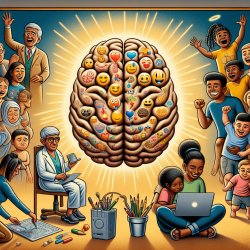Introduction
Understanding the nuances of hand preference in children is not just an academic exercise; it's a crucial component of tailoring effective therapeutic interventions. The research article "Hand preference, performance abilities, and hand selection in children" provides valuable insights into how handedness develops and its implications for performance abilities. As practitioners, leveraging these insights can significantly enhance our ability to create data-driven, personalized therapy plans that cater to the unique developmental trajectories of each child.
The Development of Hand Preference
Hand preference is a complex trait that emerges early in life and continues to evolve through childhood. The research highlights that while approximately 90% of the adult population is right-handed, the path to establishing this preference is not straightforward. Children display variable hand-use strategies, which suggests that handedness is highly malleable and influenced by both genetic and environmental factors.
From infancy to adolescence, hand preference develops through three distinct stages:
- Early Childhood (3-5 years): During this stage, children often exhibit weak and inconsistent hand preference. This variability is particularly pronounced in left-handed children, who may use both hands interchangeably as they explore their environment.
- Middle Childhood (6-10 years): As children gain more experience and practice, their hand preference becomes more consistent. They start relying more on their preferred hand, especially for tasks requiring precision, which reflects a period of motor skill refinement.
- Late Childhood to Adolescence (10-12 years): By this stage, children exhibit an adult-like pattern of handedness. They learn to be less reliant on their preferred hand as the non-preferred hand's performance improves with practice.
Implications for Practice
Understanding these developmental stages is crucial for speech-language pathologists and other practitioners working with children. Here are some practical applications:
- Assessment: Use a combination of preference and performance measures to assess handedness. Observational assessments, such as observing hand selection in reaching tasks, can provide rich data on a child's hand preference and skill level.
- Intervention Planning: Tailor interventions to the child's developmental stage. For younger children, focus on activities that encourage exploration and use of both hands. For older children, incorporate tasks that refine motor skills and encourage the use of the non-preferred hand.
- Parental Involvement: Educate parents about the importance of hand preference development and encourage activities at home that promote bilateral hand use and motor skill development.
Encouraging Further Research
The study of hand preference in children is a dynamic field with much still to explore. Practitioners are encouraged to engage with ongoing research and contribute to the growing body of knowledge. By understanding the intricacies of hand preference development, we can better support children's growth and help them achieve their full potential.
To read the original research paper, please follow this link: Hand preference, performance abilities, and hand selection in children.










